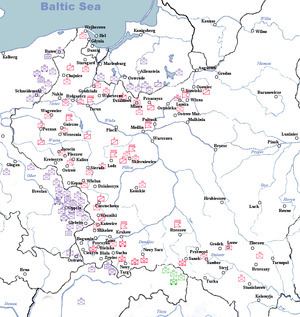Dates 1 Sep 1939 – 4 Sep 1939 | Result German victory | |
 | ||
Unknown human losses98+ tanks and AFVs1 recon plane 441+ killed7+ cars2 tankettes33 - 34 cannons11 anti-tank guns Similar Battle of Grudziądz, Battle of Władypol, Battle of Kobryń, Battle of Jaworów, Invasion of Poland | ||
Battle of Pszczyna (Polish: Bitwa Pszczyńska) refers to a series of battles between 1 and 4 September 1939 near the town of Pszczyna during the Invasion of Poland. The battle of Pszczyna formed part of the defensive Battle of the Border. The initial, decisive victory of the Polish forces on September 1, 1939 was followed by the crushing defeat on the next day near Ćwiklice, due to a major tactical error on the part of the Polish military command, resulting in premature withdrawal of the entire Armia Kraków from Upper Silesia.
Contents
Background
The battle was fought along the defense belt 20 kilometres (12 mi) wide and 70 kilometres (43 mi) long, from the west extending to the Polish-German border, and from the east to the rivers Przemsza and Soła. The Rybnicki and Kobiorski forests constituted the north-side perimeter of the battlefield, and to the south, the Vistula river along with the right tributary of Odra, the Piotrówka river provided natural protection. The defensive line some 22 kilometers in length was built by Poland already in 1929–33, as part of the strategic plan for securing the national border around the Central Industrial Region. The fortifications erected at the cost of 300,000 zł, included concrete shelters manned by the Silesian 23rd Infantry Division. In 1936–37 two new bridges were built over the Vistula and the Chochułka rivers near Goczałkowice and Pszczyna for military transport, and the supply roads were paved with asphalt in late 1930s. Overall, the defense line seemed sufficient at the time to stop a successful panzer attack. The tactical mistake of the Polish command was the assumption that the attack of the German 5th Panzer Division would require the support of infantry to secure its rear.
Overview
The battle can be divided into four phases:
During the second day of the battle Polish forces suffered a defeat and were forced to retreat. The main reason of their defeat (apart from huge German material and numerical superiority) was that the Polish commanders incorrectly predicted the direction of the main German attack on 2 September. As the result, the whole Polish plan of defense failed, because then it became impossible to activate a huge trap, which was prepared for German tanks, called the "big bag" trap, which was weak in front, but strong on its sides - with strong artillery assisting in attacking targets which entered the 'bag'. Also, overmuch certainty after great successes of the previous day (especially fierce, few hours-long combat - with use of the "big bag" trap - near Brzeźce village) contributed to Polish defeat.
Because of their certainty, Polish commanders decided to make "the big bag trap" more shallow - which meant that it was less flexible, and Polish positions would be easier to crush if the defense was not successful (as it happened) - but on the other hand - if the defense was successful (which didn't happen since the unexpected direction and strength of the German main attack were deadly), the shallow "bag" would be more effective because the German attack would be stopped faster and with greater casualties for the enemy due to a greater concentration of firepower.
The defeat suffered at Pszczyna (which also caused a loss of a significant percent of divisional artillery) forced the Polish High Command to pull back the entire frontline, and cede the territory of Upper Silesia to the Germans.
Casualty list according to monograph about the battle titled Bitwa Pszczyńska 1939 ("Battle of Pszczyna 1939") by Janusz Ryt.
After the long and bloody combat at Ćwiklice on 2 September 1939, German war correspondent K. Frowein wrote after seeing one of the Polish infantrymen heavily wounded:
This was the first Polish soldier I have ever seen. Bloody piece of human suffering. Legs pulled up to his chest because of pain, face – greenish-pale. From his thin lips almost inaudible scream was getting out – "Water! Water!". We unbuttoned his uniform jacket – smeared with blood and entrails. German orderly gave him canteen with water. For the last time a smile appeared on his face, when he whispered: "Danke". A few minutes later he died. Now he rests in peace where he fell, under a straight, wooden cross, decorated with Polish helmet and a plate with inscription: "Six Polish soldiers".
This Polish infantryman died like a real soldier. Until the end he was defending his post, completing his orders. When deadly bullets reached him, his munition holds were empty, and in the magazine of his rifle there were only 2 bullets. — War correspondent K. Frowein, 2 IX 1939.
